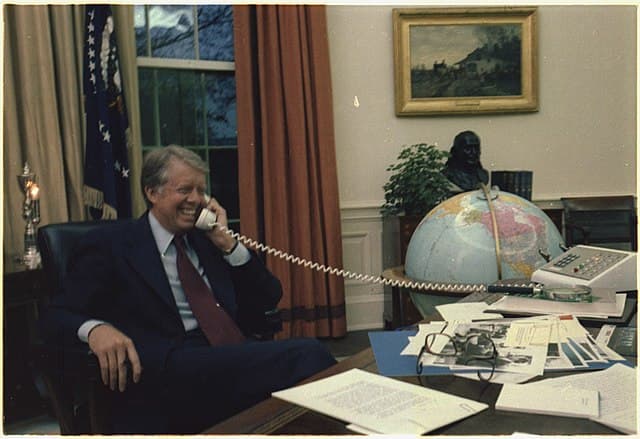Give Credit to Jimmy Carter
The Georgia governor was capable of learning from experience, which he proceeded to do as president.

Jimmy Carter, the 39th and the longest-living president, has chosen to enter hospice care at age 98. This is a good time to try to place his presidency in history. Indeed more years separate us in 2023 from Mr. Carter’s time in office than separated Mr. Carter from Franklin D. Roosevelt’s.
That was not all that separated them, either. Mr. Carter once made the point that he had never met a Democratic president, whereas Roosevelt met every Democratic president who was alive during his lifetime except for Jimmy Carter.
Mr. Carter came to office at a time of raging problems, with many resemblances to the baffling problems of today. But they were also times in which electoral politics operated very differently from how it has for the last decade or two.
Partisan lines were less sharp, voting patterns much more fluid and room for maneuver on substantive issues much greater. At his best, Mr. Carter was able to take innovative stands on perplexing issues in ways that produced lasting improvement.
The problems he faced, campaigning in 1975 and 1976 and taking office in 1977, have a familiar ring today. Inflation had been raging on and occasionally off during the decade in ways the conventional economists of the day could not explain or remedy. The nation was still reeling from a military defeat in a protracted war.
Violent crime was rising in central cities, and domestic terrorists had been setting off bombs and destroying property, mostly with impunity, for years. Quantitatively and proportionate to population, each of these negative trends was direr than its equivalent today.
Partisan preferences were in flux, far different from the red-and-blue patterns of the 21st century. In November 1976, Mr. Carter carried every Southern state except for Virginia and lost every Western state except for Hawaii. California voted Republican, Texas Democratic.
Thirty-one of the 50 states voted for a different party that year than they did in either 2016 or 2020 (or both). Only one of today’s 10 largest states backed the same party then and now — New York.
This is partly because the two parties’ nominees, the incumbent, President Ford, and Mr. Carter, were from their party’s respective historic heartlands — outstate Michigan, south Georgia — which had both been trending the other way in the turbulent 1960s and 1970s. Ford’s old congressional district, after he became vice president, elected a Democrat.
Mr. Carter’s Georgia cast the nation’s second highest percentage for John F. Kennedy in 1960 — Sherman had marched through only 96 years before — and then voted for a Republican, Senator Goldwater, in 1964 and George (“segregation forever”) Wallace in 1968. Mr. Carter ran in Democratic primaries for governor as a rural candidate, losing in 1966, winning in 1970, then beating an Atlanta-based Republican in the general election.
As governor, Mr. Carter surprised nearly everyone by hanging a portrait of Martin Luther King Jr. in the state Capitol. This seems unremarkable today. It was national news, a sign that rural white Southerners had accepted the end of racial segregation and were headed to a biracial future.
It also showed how Mr. Carter was capable of learning from experience, which he proceeded to do as president. He absorbed the lessons of Ralph Nader and free market economists and supported deregulation of airlines, trucking and freight railroads, lowering costs enormously for consumers permanently.
Early on, Mr. Carter decried “inordinate fear of Communism,” but after the invasion of Afghanistan in 1979, he said his “opinion of the Russians has changed more drastically in the last week than even the previous two and a half years.”
The result was covert action in Afghanistan and a defense buildup that, accelerated by the Reagan administration, resulted in the dismantling of the Soviet Empire a dozen years later.
Similarly, on inflation, Mr. Carter learned from failure and changed policies. He appointed Paul Volcker as Federal Reserve chairman in August 1979. Volcker’s tough, high interest-rate policies squelched inflation and sparked a quarter-century of low-inflation growth.
Mr. Carter’s top assistants — Hamilton Jordan and Jody Powell — were often brash and disrespectful of Washington insiders, but they were also highly competent and admirably loyal. Another talented but quieter aide was Stuart Eizenstat, who, in his 2018 book “President Carter: The White House Years,” makes a serious case for the accomplishments of the Carter administration, albeit while admitting some of his missteps.
The British parliamentarian Enoch Powell said that all political careers end in failure, and Mr. Carter’s most certainly did. His pollster, the late Pat Caddell, had to tell him on the morning of the Monday before the election that he had lost 10 points over the weekend and was going to lose. It must have been a tough phone call, on both ends.
These days, we don’t see so many voters changing their minds that quickly in November. But we don’t see our presidents changing their minds in response to events very often, either. So give Jimmy Carter credit for doing so, to the country’s benefit.
Creators.com

